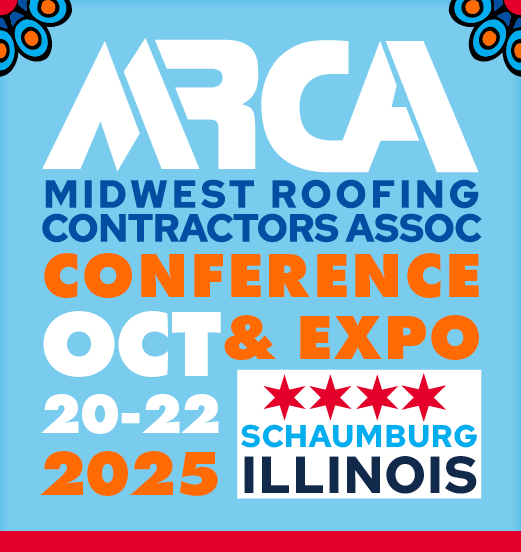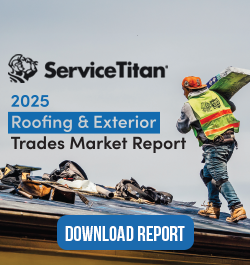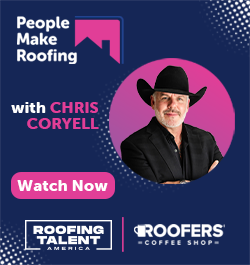Jan Bagnall - Perfecting and Maintaining Low-slope Roofs - PODCAST TRANSCRIPT
January 29, 2024 at 12:00 p.m.Editor's note: The following is the transcript of a live interview with Jan Bagnall from APOC. You can Read the interview below, Listen to the podcast or Watch on Youtube.
Intro: Welcome to Coatings Cast, the ultimate podcast dedicated to the science, art and innovation of roof coatings. It's time to roll up our sleeves, put on our lab coats and dive headfirst into the world of liquid protection that keeps your roofs in prime condition. The future of roofing is here and it's liquid, so don't miss out. This is Coatings Cast where every drop counts in the world of roof protection.
Heidi J Ellsworth: Hello, and welcome to another coatings cast from CoatingsCoffeeShop. My name is Heidi Ellsworth. I'm so excited to introduce an inventor from the roofing and coatings industry, Jan Bagnal to the show. Jan, welcome.
Jan Bagnal: Thank you, Heidi. Well, happy to be here.
Heidi J Ellsworth: You know what? I love it when I get to talk to people who've invented products, brought them to market, have done all of that, because it's just kind of exciting to see your products protecting everyone. So, before we kind of dive into that, I would love to start with an introduction. So if you could introduce yourself, who you're working with and what you're doing now, and then we'll get into all of your inventions.
Jan Bagnal: Well, my name's Jan Bagnal. I started in the roofing industry, probably, I'm going to age myself here a little bit, but 1976 I was a roofer and I learned a lot about roofing. Probably 1979 I developed a decking system because there was no such thing as a good walking roof that you have on your balconies and your patios and walkways upstairs. So, I did a lot of product development for that, a lot of testing, a lot of approvals, a lot of details and stuff for transitions.
Next thing you know, I'm on the roofing industry because roofing had problems. So, when I got in this industry, there was always a problem that I was trying to resolve. And so, my background was math. I was a math teacher for a while, but I found more fun in being outside. So, I was out here inventing this RoofSlope product. So, this RoofSlope product was, you have all these roofs that have puddles and ponds and issues with those ponds for a lot of different reasons why, and mostly deterioration of the product. So, I just developed a sloping product that works really, really well.
Heidi J Ellsworth: Excellent. And you are now part of the ICP Group working with APOC, and we have RoofSlope there. So, we really wanted to kind of talk a little bit about that. And I really wanted to start with... I know for some people out there they're going to be like, ah, we already know this, but there's a lot of people who don't. So, what are the dangers of ponding water? Let's start there. On a roof.
Jan Bagnal: Well, let's start with most roofing manufacturers, if not all of them, it'll affect their warranty. So, if you have a... Let's say you put a single ply roofing system up there, a cap sheet roofing system and it's got ponding throughout let's say the exterior wall where they have scuppers or drains. It's not really cricketed the right way. Well, the product deteriorates, then a roofing guy's going to go out there after 12 years, and all of a sudden the product's all decomposed and they're saying, "Where's my warranty at?" Well, the roofing companies, the manufacturers are not going to warranty ponding water. So, that's the number one thing that you want to probably correct.
Get back out on the East Coast where Florida and Georgia and Carolinas, and now they have an ordinance that says, "We don't want something that's going to draw as many... There's so much mosquitoes now we don't really need anymore." So, the ponding is actually against code in those areas as well. So, we're trying to get rid of those, and that's a good breeding ground for mosquitoes is on top of a roof. It's all got all that slimy mud and stuff, and that's where they're at. So, that's another reason why you want to get rid of those ponds.
Heidi J Ellsworth: That's really interesting. I always think of, well, it's just not good for the roof to have water sitting on the roof, but I hadn't even thought about pests or mosquitoes. Yeah, that is a really big problem.
Jan Bagnal: Well, you look at it, I mean, how many commercial buildings that have flat roofs and almost every one of them has some type of pond somewhere, and it's so difficult to start tearing into the roof and trying to reframe the plywood, and all of a sudden put the roof back and tie it all back in. Whereas a roof sloping product on top of it that bonds to that roof is a way easier and the fix is a lot quicker.
Heidi J Ellsworth: Yeah. And you kind of answered my question there too, but just besides the health and wellbeing of not having mosquitoes and pests and just bad water overall, that's also the weight of ponding water is not good for a healthy roof either.
Jan Bagnal: Well, that's true. I mean, I've seen roofs with major, major ponding issues where you can't even use the RoofSlope in itself because that's going to create a weight problem. So what we call a dead weight load is with nobody standing on it. And what's the maximum per square foot you're allowed to have before this roof starts caving in?
Which I've seen just recently when the snow built on some of the projects that I was on up in the mountains, the roofs were caving in because of the weight load. So you do you're right. And the more the water sits there, it seems like the more the roof sags more and now the water's even denser or even more so you're getting more weight load as each year goes by. So you're right, there's going to be situations where they got this half inch plywood up there with a big giant puddle, and next thing you know that puddle is getting mud and dirt and everything else in there. It's getting heavier and heavier and it's getting deeper and deeper. So you're right, eventually that could hurt the roof as well.
Heidi J Ellsworth: Yeah, it's really something you want to be proactive about. So let's talk about that with RoofSlope. You saw a problem and you developed a product. Tell me a little bit about that, developing that product and putting it into place.
Jan Bagnal: Well, I started the broadcast by telling you that I invented a decking system. It's the number one decking system out all over the West United States. We do the top 50 builders. That was a problem. So when I was there doing all this waterproof decking applications, the roofing guy's right next to me saying, "Nan, we need to slope this roof too." So it was obvious. So there was a problem. So there's the problem with these roofing didn't know what to do, so they were trying to do rigid installation with more product on top, and it was just very difficult to do. So they saw me sloping decks. So I jumped over to the roofing section and started sloping roofs as a trial basis on some of the guys that I knew back when I was a kid, and it all worked. So it's never been an issue.
It's a water-based product. It's very simple, so it's very user friendly. There's no chemicals, no solvents or something in it. So there's no harmful issues at all with the product. So we came out there and if there's a little bit of moisture on the deck, the product sticks even better. So we're out there teaching these roofers how to fix it. So next thing I know, when our decking system went nationwide, we jumped on that roofing product as well, and we started putting that out probably 2000 maybe eight, 2007.
Heidi J Ellsworth: Wow. Okay.
Jan Bagnal: So, we started promoting it. Even though we were using it locally on a smaller basis, we went nationwide probably about 2007 with it.
Heidi J Ellsworth: That's excellent. So okay, how does it work? Yeah, how does it work?
Jan Bagnal: Well, it displaces the water. So let's say if you have a pond and it's one inch deep and it's four foot wide, you've got a high spot on each side of that pond and a low spot in the middle. So you get a board and you can screed it across this four foot pond and it displaces that water and moves it somewhere else.
So now if you've got a spot where you have a roof that's got an outside parapet wall and you've got a scupper 10 feet from the corner and 10 feet from the other corner, and the water sits in between those scuppers. So that's a different situation. We need to build a cricket to raise that roof from left to right or right to left because you got north to south going, but you don't got east to west going. So you've got to sort of cricket between those scuppers and drains to make sure the water gets diverted. Even though it's not a low spot, it's just not sloped that way.
It's a sloped one way. The framers usually sloped one way. They don't slope in between crickets or drains. So that's the most common area we look at is between scuppers and drains, where the low spots are, because anybody's going to put a roof together, they sure as heck better at least slope the roof from the top to the bottom. That's pretty much common sense. But a lot of guys don't slope it from left to right or right to left. So you get ponds there.
You'll get ponds behind big skylights. I had a big building up in Southern California where every one of the skylights were up there and there's big giant water puddles behind the skylights. So we diverted the water around it. So it's not just filling the low spots, it's actually building up a cricket. We call them crickets to divert the water towards the scuppers where they can drain.
Heidi J Ellsworth: As you're talking about RoofSlope, just a little bit too how exactly that is applied. Talk to me about the installation on RoofSlope.
Jan Bagnal: Well, number one, I'm on the phone multiple times a day telling customers that first of all, you got to get your roof clean. So most of the roof's out there, back when I was a kid, everything was a cap sheet, was a granulated bitumen type product with granules on it, which is very simple to bond to. So we have to identify what roof system you have on there first because you could have a TPO or a PVC or an EPDM type roof, which is a single ply product type situation where we got to make sure we bond to it. So the first thing everybody has to do is identify what roofing product you have, what product you put on top of it. You might've put some type of silicone or some type of acrylic or urethane system on top of that to get the solar reflectivity rating. So we have to know what we're bonding to.
But the number one thing we do is we got to clean up. We got to make sure the contractor cleans up the area where all the mud and everything's was sitting. So we got to power wash that stuff off there so we get a good clean bond situation. We also looking at back to what kind of roof you have. So if you have... Everybody knows silicone is hard to stick to, you're not going to stick to silicone or you can get some other products that we're not quite sure what we have as far as, let's say we have a TPO or PVC, we're not going to stick to that too much either.
So what we do is we create, so that was one of our major problems we had to overtake because we always did cap sheet. That was easy because that was this granule that sticks like crazy, but how do we stick to TPO, which is plastic and hardly anything sticks to plastic. So our first year we came up with a primer that goes down to TPO, which is A TPO primer or A PVC primer. And while the primer is still wet, we would broadcast sand into it. I like to say 16 grit sand, but sometimes 30 grit works. So when you're all done, you got this primer that's bonded like crazy to this TPO or PVC with a granular surface. We stick to that great. So those type of roofs have to be prepped with a primer and a sand finish. So we establish a sand finish that we can bond to, but the cap sheets with the granulations, we don't have to do that, but with the TPO O and the PVCs we do.
Heidi J Ellsworth: Excellent. And then you just come in and you cover that with the RoofSlope product.
Jan Bagnal: Well, the good thing about, and I tell these customers, I get a lot of homeowners that are doing their own work too. So it's different when you don't have contractors, but you tell these guys, I don't think sometimes they'll get it in one application. Well, the good thing is you can put this product as almost as thick as you want and taper it to zero. So let's say the guys try to get a puddle. Let's say they have a one inch puddle and it's five foot by three foot and they screed it off. Well the next day it's all set up. So you go back out there, you put some water on and see what it looks like. You still got a quarter of an inch puddle that you're not happy with. Put another coat on. You could put multiple coat applications.
It's not like concrete where you put your concrete down if you don't got it right you're in trouble. With this one here if you don't got to write, you could add a quarter layer on top of it and then another one on top of that. So you can go multiple layers until you're happy. And then once you're done with that, you could put anything you want on top.
If it's a granulated roof, like let's say we'll go back to the cap sheet, which is very popular. They sell granules. The roofing yards sell granules. It's a ceramic granule that matches the cap sheet. So when you spread out the RoofSlope product, you could throw granules on top of it and by the time it's done, except it's cleaner and newer looking, it looks just like the cap sheet. But once it's done, if you say, you know what, we had this coating, we had this urethane coating on top of this solar reflectivity coating, we want to put that back on, no problem. You could put anything you want on top of the RoofSlope. You can put torch down on top of it. It's Fine. Everything sticks to the RoofSlope. We just have to make sure the RoopSlope sticks to what we're going over.
Heidi J Ellsworth: Right. Which is always a little bit of the trick. Okay. And you kind of talked a little bit about this, but let's talk about some of the benefits of using the RoofSlope product. You talked about primers, right? On certain things. But on cap sheet you don't need primers. So just give us an idea overall of the benefits of RoofSlope.
Jan Bagnal: Well, the benefits are you're going to extend the length of your roof. You're going to make sure that it's codeable 30 years instead of 15 or 13. You're going to get rid of the issues with pests, especially mosquitoes. You're going to have a situation where you have solar reflectivity, where you get water and ponding and mud and everything else you'd lose that. So now all of a sudden you put it back to where it's supposed to be on a roof that's going to last you 30 years.
And I tell you what, this part of the roof, in my opinion, I'm not sure we've had testing on it, but it's a total UV resistant roof. The strongest part of that roof when you're all said and done is going to be where the RoofSlope is. That stuff, it's a 6,000 PSI product. It means it's really super durable. It's walkable. It's a similar product that we use in our decking system. That's everywhere. I mean, our decking system goes all over the United States. It's 6,000 PSI. It's UV resistant. So you're going to have this roof roofing system up there. It's going to be the strongest part of your roof. It's going to get rid of all the issues of your roof deteriorating before it needs to.
Heidi J Ellsworth: Wow. That is cool. And like you said, I know it's codeable, it dries quick. So as people are installing it, what kind of training should you be doing with your crews to utilize RoofSlope? I mean, I want to talk a little bit because you really have intrigued me when I'm thinking about service and maintenance and you go up and you may see that there's some ponding and you just want to get that. It may not need a whole new roof. It just, you realize service and maintenance that there's ponding. How are you training the technicians? What are some of the things that the contractors should be doing to make sure that they can utilize this to keep roofs healthier longer?
Jan Bagnal: There's a whole nother subject to what roofers need to do. Let's say if they have a leaking situation, how to fix that leak comes down to the roofing product and the roofer that they're going to fix that. Is RoofSlope a waterproofing product? Yes, but it's not something that we're going to warranty when you have a pond that's 100 square feet and you've got a 100,000 square foot roof. So we don't get into where we're going to warranty waterproofing, even though it is a waterproofing product and it will probably resolve some waterproofing issues. That's not what our intent is. But what you want to do is you definitely want the contractor to identify what's wrong with the roof first to see if it's ponding. We can fix that. That's a simple thing to do.
As far as training goes, it's simple because there's not sheet metal flashing involved. There's not all these transitions on different things that you do as a roofing around pipes and all that kind of stuff. So the simplicity of the product, and as forgiving as it is, as you can put the product down and you mess it up a little bit, you can add more product. If you want to make it smoother, you can. If you want to make it thicker or you want to make it more slope, you can always do that. So it's not like a finished product that you're walking into your front door and it's got to be perfect like a wood or tile. You can get it a little bit ratty if you want, and nobody would know the difference.
But it's real simple to do. It self-levels and it's very, very simple to make work. I usually tell people, you guys, there's a minute and a half video online on RoofSlope.com. Look at that minute and a half video. If you don't get it, call me back. But it's very, very simple. You mix it up, you pour it down. That's simple.
I mean you mix it a certain thickness. I like it the self-leveling type that you can mix it and sort of float it out. It still keeps its depth that let's say an inch and a half to zero. But it's more like, and I tell everybody this, I go, "It's more like pancake mix," because it comes in a 50 pound bag or 50 pound bucket and you add a gallon and a quart of water. Well, let's say you don't need all that product. It's like, "I'm not going to go buy a bucket of product and then mix it all up and use half of it and throw the other half away." You could mix up half of it.
And how you mix it. So now they go, well, how do I measure the water? I'm only using this much." I go, "Well, I always tell people, make it look like pancake mix." I go, "If you mix it too thick and you pour it out of your whatever onto the pan and it's not spreading like a pancake, you got it too thick." It'll set up, but it won't self-level very well. And if you've got it too wet, your pancakes, you can't pour a pancake inside your pan. And again, it just goes out everywhere. You need to have some type of thickness. So that's what the mix looks like.
And so when I train people on phone, I say, "Listen, make it look like pancake mix. It's not going to hurt you if it's a little bit too thick. It just doesn't self-level as easy. But the pancake mix trick is what you want to look like." Plus the video online, it's a minute and a half. I say, "You guys, go on RoofSlope. It's a minute and a half video. If you have any questions give me a call, but most guys look at that and say, "I got it," even the homeowners.
Heidi J Ellsworth: Yeah, it's easy. So what are you hearing back from contractors who are using RoofSlope to do repairs? And I assume a lot of it is repairs, but some of it might be on a new roof too that just didn't get leveled or didn't get put incorrectly, right?
Jan Bagnal: Yeah, great question. Listen, I've been with this product indirectly with RoofSlope and the other company that I invented for 45 years where there's never been any litigation ever. There's 100% response that everyone says this works great. I've never had anybody say, boy, this stuff doesn't work. It lasts. It's 6,000 PSI. Once you put it down, you're not getting it off. It works. I've never had anybody that didn't like it. It's great.
The problem I have sometimes is people out in the middle of nowhere says, where do I get it at? We have distributors all over America, but sometimes getting the product to them is a little bit of a chore. But when you have a distributor like ABC Supply or Beacon who have a 1,000 different locations and somebody's out in the middle of Timbuktu somewhere and you don't know how to get them, you have to start looking online and say, "Where's my nearest location I can buy the product?" And sometimes it's even as much where guys have to transfer it in, but there's a ton of different distributors that have the product. But sometimes I have tell people where to go where they can find it easier and maybe get a transferring because they don't want to travel 100 to get a couple bags of stuff. So it's not like we have it at Home Depot. We got it online at all the roofing supply yards.
Heidi J Ellsworth: Okay. So they can get it from there pretty easily. And the contractors, I mean, when you're talking about 45 years that you've had these products out there, you must have just so many testimonials and stories from contractors on how it's helped them. Share a little bit of that with us.
Jan Bagnal: Well, I used to have a partner back in my decking system days, one of the greatest guys ever, and he would watch me do my seminars again and again and again. Because I did every architect and every consultant and every major builder I got to do seminars for and he heard the same stories. He just goes, "You just tell way too many stories. You got to cut down on the stories." I go, "I can't help it. It makes sense because it applies to what I'm trying to teach them."
But there's a lot of stories, and you're right. There's guys out there that I've been involved with so many different companies now, and it's been a journey. I don't think I'm ever going to retire because I have so many friendships in this industry now, but you're right there's a lot of stories that I tell, which is apropos to what we're doing.
Heidi J Ellsworth: Yeah.
Jan Bagnal: So, the main thing is it's great having a product out there, number one, that works. The functionality is fantastic. So it's like when we're selling this RoofSlope product, we're saving the contractor a ton of time and a ton of money. It's just simple. And people always ask, "Boy, if I could do this, it'd be great," but they don't have the right product. They're trying to put different stuff in there that's not waterproof. This is a waterproofing product that's going to hold that's going to make that water drain off. It just works. And if it doesn't work, you put more on. So it's never been a problem. So it's really a great product for these guys.
Heidi J Ellsworth: Yeah. I love that. So really any roofing contractor, any roofing technician, any folks out there, if they walk up on a roof and they see ponding water, the first thing they should be thinking about is RoofSlope?
Jan Bagnal: Well, I would think so. I mean, if it's my roof and it's my building, I know I'm not going to get the life out of that roofing system and taking the whole roofing system off and fix and plywood or doing or what else you're going to do is a lot more expensive than putting a couple bags and stuff down and making sure you divert the water out. So it is a really good answer to what people have as far as issues on their roofs. They could fix it.
The only thing we're looking at is making sure that the roofing system was put down the right way. The hardest thing I've got, I think, and this is back in the day, so I'm going to age myself again here, but back in the day there was the rock roofs where You put the hot tar down-
Heidi J Ellsworth: Oh yeah.
Jan Bagnal: ... you throw the rocks on top, and the rocks are supposed to keep the sun reflecting away from all the felt paper below. So it makes the felt paper last longer. And those are a little bit archaic now. There's not so many rock roofs out there. There's all single-ply roofs and stuff. So once in a while I run into that. So they're saying, "What are we going to do with this rock roof? Well, what's going to stick to hot tar and rock and dirt and everything else?"
So that becomes a little bit of a challenge. I can't say that we haven't gone over them a few times, but that's probably the challenge that I don't want to hear on the phone that, "Hey, I got a bunch of rock up there. I want to try to divert this water." It's a little bit more difficult for me, but I can do it.
Heidi J Ellsworth: You can do it?
Jan Bagnal: Yeah.
Heidi J Ellsworth: Wow, that is great. And you already answered one of my questions. I was wondering where can they get it? So ABC, Beacon, through any major roofing distributor.
Jan Bagnal: Yeah, SRS is out there, Beacon, ABC Supply and there's a lot of smaller distributors that have 4 or 5 or 10 different distributors that also have it. I couldn't name them all because they're out throughout the country. But the best thing is you go on RoofSlope.com and you'll see all the local guys, and I wouldn't even be able to tell you half the names out there. There's a lot of them that have it, but it's readily available. I wish it was at something like Home Depot where everybody can just go down a mile and half from their house and pick up, but it's at a roofing yard, so sometimes you got to drive 10 miles. But we do have it across the country.
Heidi J Ellsworth: That's great. That's great. I just love the fact that you have been able to invent this and be able to follow its journey and to be where you're at today. And you told me you're going to be walking IRE this year and checking out and meeting all your friends. What an amazing career, Jan. I just find it inspirational.
Jan Bagnal: Well, it's been fun. And the thing I get asked in the industry, because I've been around for a long time, is when you retiring? I go, "Well, I got a family. I got three kids and some grandkids, and I'm not leaving that alone because I love that family so much, but this family in the industry with all the different builders and applicators and roofers and architects and consultants that I know, I can't leave that family either. I got to stay around." So I have too many friends out here.
So I love walking projects and helping people out. I tell people, if they don't know what they're doing, get me out there. We have reps throughout the country that can help people in all these different locations that it's pretty easy to look to get this thing done. But when people are just not real sure, then we help them out. We'll get out there and make sure we get out there and make sure they know what they're doing.
Heidi J Ellsworth: That's great. That is great. It has just been a delight meeting you and visiting about RoofSlope and your career. I look forward to seeing you at IRE.
Jan Bagnal: I will see where you're at. I'd love to come say hi to you, Heidi.
Heidi J Ellsworth: Perfect. We'll be right in the lobby, so be sure to check it out. And Jan, thank you so much. I really appreciate your time today. This was great.
Jan Bagnal: I appreciate the opportunities to share what I've been going through my whole life. So thank you for the opportunity.
Heidi J Ellsworth: It's awesome. And for everyone out there, you can find all this information on the ICP and the APOC directories on Roofers Coffee Shop and Coatings Coffee Shop, so Coatings Coffee Shop. You'll also find all kinds of articles, all kinds of great stuff. So be sure to check all that out along with all of the Coatings Cast podcasts that are underneath the Read, Listen and Watch initiative. Be sure to subscribe on your favorite podcast channel and on YouTube. Set the notification so you don't miss a single episode. We will be seeing you next time on Coatings Cast.
Outro: Thanks for joining us on this coating adventure. Stay tuned for more episodes. And in the meantime, be sure to follow us on all social media to stay up to date with all things roof coatings. Until next time, stay coated. For more information, go to CoatingsCoffeeShop.com.
























Comments
Leave a Reply
Have an account? Login to leave a comment!
Sign In